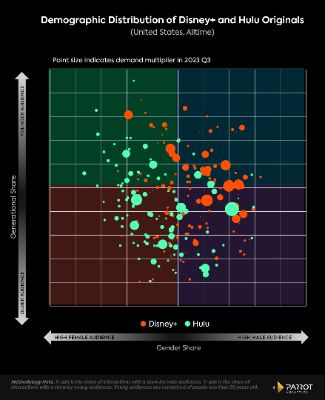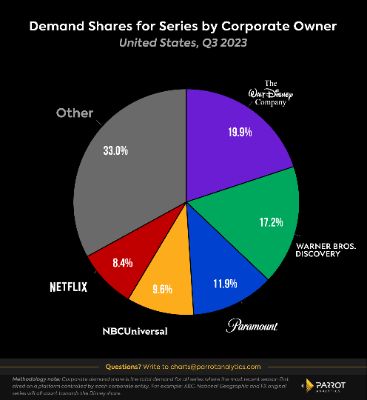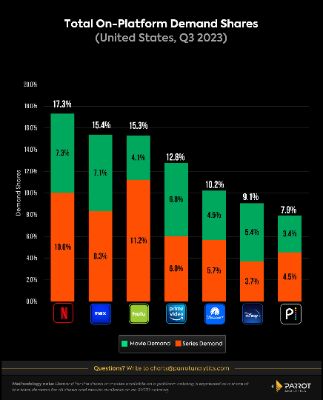The two largest companies by corporate demand share report earnings on Wednesday, facing similar fundamental issues heading into 2024 and beyond.
Disney and Warner Bros. Discovery (and its predecessors) have diligently followed Wall Street’s shifting moods over the last half decade. Disney chased Netflix’s streaming subscriber growth-at-all-costs business model and was handsomely rewarded at first before the bill came due in 2022.
WBD’s very existence is the result of an attempt to create a Netflix competitor by combining the media assets of then-AT&T’s WarnerMedia (née Time Warner) under streaming-focused CEO Jason Kilar, with those of then-Discovery Communications.
As of November 2023, Disney‘s market cap sits at less than half of its peak valuation from March 2021, and WBD is valued roughly the same as the Hulu platform.
If any two companies in the industry are relatively ‘strike proof it should be Disney and WBD. They have the most in-demand libraries to keep streamers as fresh as possible, and access to the most popular live sports.
But with massive debt loads, shrinking linear TV businesses, and cracks appearing in previously untouchable franchises, both companies have put virtually everything on the table to get their media and streaming arms to consistent profitability. Once golden geese such as ESPN, NBA rights, premium scripted content exclusivity, and more are now up for sale.
Heading into 2024, the Magic Kingdom and Dream Factory are being forced to wake up and smell the pixie dust.
Hulu Deal

- Disney’s recent announcement that it will carry out its 2019 agreement to buyout Hulu should end up costing the company north of $9B, at a time when cost cutting is the name of the game.
- In terms of content, Disney presumably bringing Hulu into Disney+ makes sense from a scale perspective. Disney+ and Hulu combined would easily overtake Netflix as the platform with the most total catalog demand — including all TV series and movies available — with US audiences. Parrot Analytics audience demographic data shows that Hulu and Disney+ originals would combine well to form a true four quadrant service.
- While the price tag is high, the Hulu buyout will result in increased synergies for Disney. According to Parrot Analytics, integrating key Hulu originals and additional library content into the Disney+ app could prevent around $500 million in at-risk churn revenue, and add an additional $750 million in advertising revenue.
- However, it’s also fair to wonder how a combined single service app may affect churn, which the Disney bundle is effective at mitigating.
Warner Bros. Discovery

- WBD’s raison d'etre, Max, serves as one example of how to integrate massive content libraries into one app. Combining Discovery originals onto the old HBO Max platform has created a four quadrant service that is second only to Netflix in terms of total catalog demand with US audiences. However, subscriber growth for Max has plateaued and even ticked down in Q2 2023.
- After building a walled garden streaming service, WBD is now back to licensing out some of its premium content, including HBO Originals and DC films, even to Netflix.
- These moves will help WBD’s bottomline line, and have increased demand for the licensed content, but it may also be pulling consumers back to Netflix and help it further its lead over the field.
How To Leapfrog Disney?

- Corporate demand share assesses the long-term viability of the top media companies as they look to consolidate their original content’s availability exclusively onto their own platforms, and can effectively help value a conglomerate’s legacy and library content in aggregate.
- Since the Discovery-WarnerMedia merger went through in April 2022, Disney and WBD have been the top two media conglomerates in corporate demand share. Disney has historically been the biggest slice of this pie chart. These two companies alone account for 37.1% of the demand for all TV content with US audiences as of Q3 2023.
- WBD’s most straightforward path to leapfrogging Disney in this category is to join forces with a competitor. A combination with either NBCUniversal or Paramount Global would put either new entity ahead of Disney in Corporate Demand Share.
- While the Hulu buyout should improve Disney’s streaming business, Disney may be arming Comcast with the funds to make an industry-shifting acquisition. Comcast CEO Brian Roberts made failed attempts to acquire both Disney and 21st Century Fox. Regulatory hurdles aside, could the third time for Roberts finally be the charm when it comes to Warner Bros. Discovery?
Go-To Streaming Home

- Demand for original series drives subscription growth, and library content is key for customer retention, an increasingly crucial element of all streaming strategies as the market matures and consumers are offered more choice and easier ways to cancel than ever.
- Library content will also be a crucial short-term asset as Hollywood’s labor strikes prolong, with new shows and movies likely to run dry in into early 2024 and beyond.
- There is a clear ‘Big Three’ in terms of general entertainment platforms. WBD’s Max just edge’s out Hulu for second place behind Netflix in this category.
- That said, once Hulu (15.3%) and Disney+ (9.1%) are combined, that new Disney streamer should easily top both Netflix and Max when it comes to total on-platform demand for content.



 Business Canterbury: Urges Council To Cut Costs, Not Ambition For City
Business Canterbury: Urges Council To Cut Costs, Not Ambition For City Wellington Airport: On Track For Net Zero Emissions By 2028
Wellington Airport: On Track For Net Zero Emissions By 2028 Landcare Research: ANZAC Gall Fly Release Promises Natural Solution To Weed Threat
Landcare Research: ANZAC Gall Fly Release Promises Natural Solution To Weed Threat NZ Anti-Vivisection Society: Auckland Rat Lovers Unite!
NZ Anti-Vivisection Society: Auckland Rat Lovers Unite! University of Canterbury: $1.35 Million Grant To Study Lion-like Jumping Spiders
University of Canterbury: $1.35 Million Grant To Study Lion-like Jumping Spiders Federated Farmers: Government Ends War On Farming
Federated Farmers: Government Ends War On Farming



